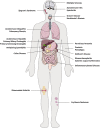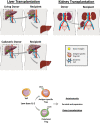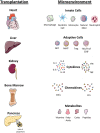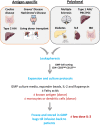The Next Frontier of Regulatory T Cells: Promising Immunotherapy for Autoimmune Diseases and Organ Transplantations
- PMID: 33072105
- PMCID: PMC7538686
- DOI: 10.3389/fimmu.2020.565518
The Next Frontier of Regulatory T Cells: Promising Immunotherapy for Autoimmune Diseases and Organ Transplantations
Abstract
Regulatory T cells (Tregs) are crucial in maintaining tolerance. Hence, Treg immunotherapy is an attractive therapeutic option in autoimmune diseases and organ transplantations. Currently, autoimmune diseases do not have a curative treatment and transplant recipients require life-long immunosuppression to prevent graft rejection. There has been significant progress in understanding polyclonal and antigen-specific Treg biology over the last decade. Clinical trials with good manufacturing practice (GMP) Treg cells have demonstrated safety and early efficacy of Treg therapy. GMP Treg cells can also be tracked following infusion. In order to improve efficacy of Tregs immunotherapy, it is necessary that Tregs migrate, survive and function at the specific target tissue. Application of antigen specific Tregs and maintaining cells' suppressive function and survival with low dose interleukin-2 (IL-2) will enhance the efficacy and longevity of infused GMP-grade Tregs. Notably, stability of Tregs in the local tissue can be manipulated by understanding the microenvironment. With the recent advances in GMP-grade Tregs isolation and antigen-specific chimeric antigen receptor (CAR)-Tregs development will allow functionally superior cells to migrate to the target organ. Thus, Tregs immunotherapy may be a promising option for patients with autoimmune diseases and organ transplantations in near future.
Keywords: antigen specific; autoimmune liver diseases; liver transplant; polyclonal; recruitment; regulatory T cell; tolerance.
Copyright © 2020 Terry and Oo.
Figures




Similar articles
-
Regulating the regulators: Is introduction of an antigen-specific approach in regulatory T cells the next step to treat autoimmunity?Cell Immunol. 2020 Dec;358:104236. doi: 10.1016/j.cellimm.2020.104236. Epub 2020 Oct 13. Cell Immunol. 2020. PMID: 33137651 Review.
-
Chimeric Antigen Receptor (CAR) Treg: A Promising Approach to Inducing Immunological Tolerance.Front Immunol. 2018 Oct 12;9:2359. doi: 10.3389/fimmu.2018.02359. eCollection 2018. Front Immunol. 2018. PMID: 30369931 Free PMC article. Review.
-
Challenges and opportunities in achieving effective regulatory T cell therapy in autoimmune liver disease.Semin Immunopathol. 2022 Jul;44(4):461-474. doi: 10.1007/s00281-022-00940-w. Epub 2022 May 31. Semin Immunopathol. 2022. PMID: 35641679 Free PMC article. Review.
-
Exploiting regulatory T cells (Tregs): Cutting-edge therapy for autoimmune diseases.Int Immunopharmacol. 2025 May 16;155:114624. doi: 10.1016/j.intimp.2025.114624. Epub 2025 Apr 10. Int Immunopharmacol. 2025. PMID: 40215774 Review.
-
Antigen-Specific Regulatory T Cell Therapy in Autoimmune Diseases and Transplantation.Front Immunol. 2021 May 14;12:661875. doi: 10.3389/fimmu.2021.661875. eCollection 2021. Front Immunol. 2021. PMID: 34054826 Free PMC article. Review.
Cited by
-
Interplay between Mast Cells and Regulatory T Cells in Immune-Mediated Cholangiopathies.Int J Mol Sci. 2022 May 24;23(11):5872. doi: 10.3390/ijms23115872. Int J Mol Sci. 2022. PMID: 35682552 Free PMC article. Review.
-
[Allogeneic unrelated non HLA matched umbilical cord blood transfusion for refractory immune cytopenia: results of a phase I clinical trial].Zhonghua Xue Ye Xue Za Zhi. 2023 May 14;44(5):431-435. doi: 10.3760/cma.j.issn.0253-2727.2023.05.014. Zhonghua Xue Ye Xue Za Zhi. 2023. PMID: 37550196 Free PMC article. Clinical Trial. Chinese. No abstract available.
-
Quis Custodiet Ipsos Custodes (Who Controls the Controllers)? Two Decades of Studies on HDAC9.Life (Basel). 2021 Jan 27;11(2):90. doi: 10.3390/life11020090. Life (Basel). 2021. PMID: 33513699 Free PMC article. Review.
-
Targeting Enclysis in Liver Autoimmunity, Transplantation, Viral Infection and Cancer.Front Immunol. 2021 Apr 19;12:662134. doi: 10.3389/fimmu.2021.662134. eCollection 2021. Front Immunol. 2021. PMID: 33953725 Free PMC article. Review.
-
Interleukin-5 (IL-5) Therapy Prevents Allograft Rejection by Promoting CD4+CD25+ Ts2 Regulatory Cells That Are Antigen-Specific and Express IL-5 Receptor.Front Immunol. 2021 Nov 29;12:714838. doi: 10.3389/fimmu.2021.714838. eCollection 2021. Front Immunol. 2021. PMID: 34912327 Free PMC article.
References
-
- Sakaguchi S, Sakaguchi N, Asano M, Itoh M, Toda M. Immunologic self-tolerance maintained by activated T cells expressing IL-2 receptor alpha-chains (CD25). Breakdown of a single mechanism of self-tolerance causes various autoimmune diseases. J Immunol. (1995) 155:1151–64. - PubMed
-
- Itoh M, Takahashi T, Sakaguchi N, Kuniyasu Y, Shimizu J, Otsuka F, et al. . Thymus and autoimmunity: production of CD25+CD4+ naturally anergic and suppressive T cells as a key function of the thymus in maintaining immunologic self-tolerance. J Immunol. (1999) 162:5317–26. - PubMed
Publication types
MeSH terms
Substances
Grants and funding
LinkOut - more resources
Full Text Sources
Medical

